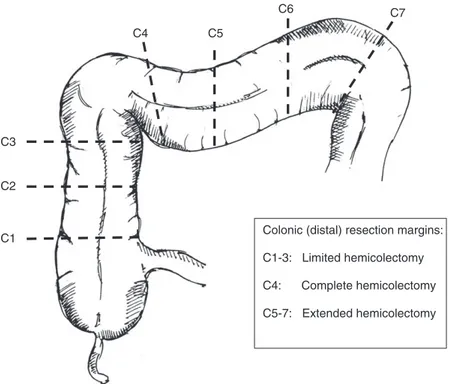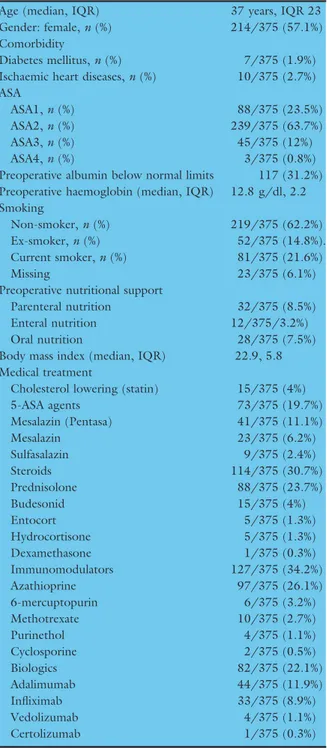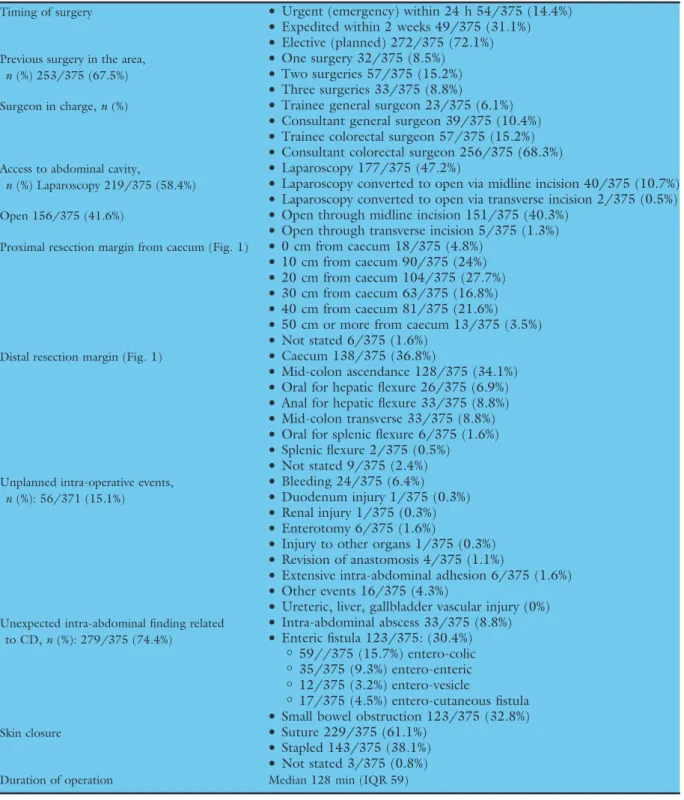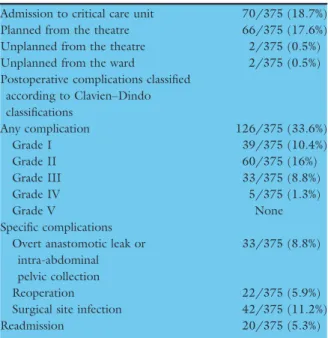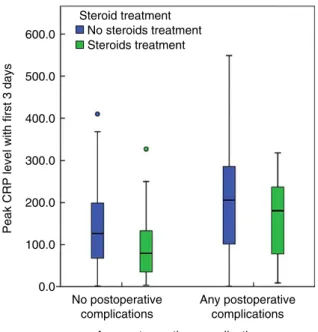Risk factors for unfavourable postoperative outcome in patients
with Crohn’s disease undergoing right hemicolectomy or
ileocaecal resection. An international audit by ESCP and
S-ECCO
2015 European Society of Coloproctology collaborating group1
Received 26 July 2017; accepted 30 August 2017; Accepted Article online 15 September 2017
Abstract
AimPatient- and disease-related factors, as well as operation technique, all have the potential to impact on postoperative outcome in Crohn’s disease. The available evidence is based on small series and often displays con-flicting results. The aim was to investigate the effect of preoperative and intra-operative risk factors on 30-day postoperative outcome in patients undergoing surgery for Crohn’s disease.
MethodThis was an international prospective snapshot audit including consecutive patients undergoing right hemicolectomy or ileocaecal resection. The study anal-ysed a subset of patients who underwent surgery for Crohn’s disease. The primary outcome measure was the overall Clavien–Dindo postoperative complication rate. The key secondary outcomes were anastomotic leak, reoperation, surgical site infection and length of stay in hospital. Multivariable binary logistic regression analyses were used to produce odds ratios and 95% confidence intervals.
ResultsIn all, 375 resections in 375 patients were included. The median age was 37 and 57.1% were women. In multivariate analyses, postoperative compli-cations were associated with preoperative parenteral nutrition (OR 2.36, 95% CI 1.10–4.97), urgent/expe-dited surgical intervention (OR 2.00, 95% CI
1.13–3.55) and unplanned intra-operative adverse events (OR 2.30, 95% CI 1.20–4.45). The postopera-tive length of stay in hospital was prolonged in patients who received preoperative parenteral nutrition (OR 31, 95% CI 1.08–1.61) and those who had urgent/expe-dited operations (OR 1.21, 95% CI 1.07–1.37). ConclusionPreoperative parenteral nutritional support, urgent/expedited operation and unplanned intra-operative adverse events were associated with unfavourable postoper-ative outcome. Enhanced preoperpostoper-ative optimization and improved planning of operation pathways and timings may improve outcomes for patients.
Keywords Crohn’s disease, surgery, resection, postoperative complications, outcome, parenteral nutrition
What does this paper add to the literature? We describe the first international prospective multicen-tre study to collect contemporaneous data on this chal-lenging patient cohort. Much of the literature to date consists of small and retrospective series, often from sin-gle centres. We identify the common risk factors associ-ated with unfavourable postoperative outcome and make suggestions for potential pathway improvements such as better timing of surgical intervention and preop-erative optimization.
Introduction
The postoperative outcome of surgery for Crohn’s dis-ease (CD) may be affected by patient, disdis-ease, surgical, technical and other perioperative risk factors. Retrospec-tive observational studies have identified several patient-related and disease-patient-related risk factors, including body
Correspondence to: Alaa El-Hussuna, Aalborg University Hospital, Hobrovej 18–22, 9000 Aalborg, Denmark.
E-mail: [email protected] 1
Collaborating members are shown in the Appendix S1, in Supporting information.
The paper was presented at the S-ECCO Masterclass in IBD Surgery in Amsterdam 2016 and the ESCP Annual Meeting, Milan 2016.
mass index [1], smoking [2], preoperative intra-abdom-inal abscess or enteric fistula [3], preoperative albumin [4–6], anaemia [7,8], malnutrition [9,10] and preopera-tive medical treatment [11–13].
Surgeon- and surgery-related risk factors might also be crucial to outcome. The rate of first-time intestinal resection in CD is 29.1% while the 7-year cumulative risk is 28.5% [14]. Surgery in CD patients remains challeng-ing in terms of timchalleng-ing [15], preoperative optimization [8,16,17] and techniques [18]. Many of the suspected risk factors are somewhat controversial, including sur-geon’s grade of specialization [19], preoperative opti-mization [8], urgency of surgical intervention [15], use of defunctioning ileostomy [20] and method of access to abdominal cavity [21]. Anastomosis type and configura-tion have also been debated without robust evidence to support one type or another to date [22,23]. The same applies for the skin closure technique, which has been investigated in obstetrics [24] and orthopaedic [25] sur-gical wounds but not in CD patients.
The quality of evidence supporting the previously described risk factors is low in the majority of studies due to small sample size and their retrospective nature. There is need for a prospective multicentre study with a large sample size. Our aim was to investigate the effect of patient-, disease- and surgery-related risk factors on the 30-day postoperative outcome in CD patients undergoing right hemicolectomy or ileocaecal resection.
Method
Study design
This was a prospective, multicentre, international snap-shot audit of patients undergoing elective or emergency right hemicolectomy or ileocaecal resection over a 2-month period (mid-January to mid-March 2015). Patients were followed up for 30 days after the primary operation. The audit was performed according to a pre-specified protocol (http://www.escp.eu.com/research/c ohort-studies/2015-audit). The methods used were explained in the recently published primary report from the main study [26]. This study, including only patients undergoing surgery to treat CD, comprises a pre-specified subgroup analysis.
Objectives
Our aim was to investigate patient- and surgery-related risk factors that might affect postoperative outcome in CD patients undergoing ileocaecal resection or right hemicolectomy. These factors included age, gender, comorbidity (diabetes and ischaemic heart disease),
smoking status, body mass index, statin medication, med-ical treatment for CD (steroids within 1 week prior to operation, 5-aminosalicylic acid within 1 week prior to operation, immunomodulators within 4 weeks prior to operation, biologics within 12 weeks prior to operation), intra-abdominal abscess/pelvic collection, albumin, serum creatinine, haemoglobin, nutritional sup-port (oral, enteral and parenteral nutrition) and American Society of Anesthesiologists (ASA) grade.
Also, surgeon- and surgery-related factors were col-lected: urgency of surgery (urgent, i.e. within 24 h; expe-dited, i.e. within 2 weeks; and elective), previous surgery in the area, details of surgeon in charge (traineevs consul-tant, colorectal vs general surgeon), access to abdominal cavity (open, laparoscopic or laparoscopic converted to open), extent of proximal resection (Fig. 1), details of anastomosis (type, configuration, instruments used), defunctioning/primary stoma, skin closure (suture or sta-pling), operation duration, and unplanned intra-operative adverse events (UIAEs) including injury to liver, gallblad-der, duodenum, kidney, ureter, major blood vessels and bowel injury.
Outcome measures
The primary outcome measure was the overall postoper-ative complication rate classified according to the Clavien–Dindo scale (Grade I to V). The secondary outcome measures were
1 clinically suspected anastomotic leak defined as either (i) gross anastomotic leakage proved radiologically or clinically or (ii) the presence of an intraperitoneal (abdominal or pelvic) fluid collection on postopera-tive imaging;
2 surgical site infection within 30 days defined accord-ing the Centers for Disease Control criteria;
3 unplanned reoperation within 30 days; 4 length of postoperative stay in hospital (LOS).
Inclusion criteria
Adult patients undergoing right hemicolectomy or ileo-caecal resection at a participating hospital during the study period, for CD pathology, via any operative approach and in both the elective and emergency set-tings, with or without primary anastomosis, performed by colorectal, general or trainee surgeons were included.
Exclusion criteria
Patients undergoing right hemicolectomy or ileocaecal resection as part of a bigger procedure such as subtotal
colectomy or pan-proctocolectomy, patients in whom the distal colonic transaction point was beyond the sple-nic flexure and patients undergoing additional upstream strictureplasty or resection to treat concurrent small bowel disease more proximally during the same opera-tion were excluded.
Statistical analysis
Pearson’s chi-squared and Fisher’s exact tests were applied for categorical variables in univariate analysis, while Mann–Whitney’s test was used for continuous variables. Continuous variables are reported by median and interquartile range (IQR). Univariate and multivari-ate regression models were used to assess the association between risk factors and outcome. For binary outcomes (e.g. complication yes/no), binary logistic regression modelling was used to produce odds ratios. For contin-uous variables (e.g. LOS), normality was tested and lin-ear regression modelling was used, with results presented as exponential transformations of the regres-sion coefficients. Logarithmic transformation was imple-mented when needed. Covariates included in regression models were those statistically significant in univariate analyses or those deemed important from clinical experi-ence. Results are presented with corresponding 95% confidence interval. A P value< 0.05 was considered
significant. SPSS version 19 was used for descriptive and univariate analyses while R was used for multivariate analyses.
Results
Within the full audit cohort of 3041 patients, 375 oper-ations were performed for CD patients in 151 centres around the world. The operations included in this study represent a subgroup of the main European Society of Coloproctology (ESCP) audit cohort [26].
Preoperative status
Patients’ demographics and preoperative data are reported in Table 1. Fourteen patients (3.7%) had an abnormal serum creatinine level preoperatively, and 114 (30.4%) had albumin below normal levels (defined by local laboratories in the participating hospitals). Sixty-eight patients (18.1%) had a preoperative intra-abdom-inal abscess; however, only 18 (4.8%) had their abscess drained preoperatively with a median interval between abscess drainage and surgery of 29 days (IQR 37). Seventy per cent of patients (263/375) were on one or more types of medical treatment (Table 1). Sixty-six patients (17.8%) received a high steroid dose (defined as 20 mg or more) preoperatively [11]. C1 C2 C3 C4 C5 C6 C7
Colonic (distal) resection margins:
C1-3: Limited hemicolectomy
C4: Complete hemicolectomy
C5-7: Extended hemicolectomy
Figure 1 A screen shot of the figure used in the data collection process to map the extent of resection: I, the proximal resection margin; C, the distal resection margin.
Intra-operative details
Details of surgical procedures are shown in Table 2. Colorectal specialists, in elective settings, did more than two-thirds of the procedures. The proximal resection margin was 10–30 cm upstream from the ileocaecal
valve in the majority of patients and through the cae-cum or ascending colon distally. A primary anastomosis was performed in 334/375 (89.1%) of the patients; of these 65.9% (220/334) were stapled. Side to side (215/334) stapled anastomoses was the most commonly used configuration usually in the form of extra-corporal anastomosis (105/334). Stomas were constructed in 46/375 (12.3%) of patients.
Postoperative course
In all, 126 patients (33.6%) had one or more postoperative complications, of whom 22 (7.3%) had a complication requiring reoperation within 30 days (Table 3). Median LOS was 7 days (IQR 5). The unplanned readmission rate was 5.3% (20/375).
Univariate analysis
Postoperative complications were associated with par-enteral nutrition, comorbidity, urgent/expedited opera-tions and UIAEs (Table 4). The risk of reoperation increased in patients who received parenteral nutrition (P= 0.14, OR 3.551, 95% CI 1.216–10.370) and stapled skin closure (P= 0.023, OR 2.763, 95% CI 1.115–6.842). Surgical site infection correlated with low preoperative albumin (P= 0.038, OR 0.507, 95% CI 0.264–0.973), parenteral nutrition (P= 0.01, OR 3.029, 95% CI 1.263– 7.267), open access to the abdominal cavity (P= 0.03, OR 0.493, 95% CI 0.257–0.943) and stapled skin closure (P< 0.001, OR 2.958, 95% CI 1.525–5.737).
Medical treatment was not associated with an increased risk of postoperative complications or reopera-tion even when this was investigated for each type of the above-mentioned drug categories and different sur-gical procedures.
Prolonged postoperative LOS (Fig. 2) correlated with parenteral nutrition (P= 0.002), ASA grade 3 and 4 (P< 0.001), urgent/expedited operations (P< 0.001) and stoma construction (P < 0.001).
As Fig. 3 shows, peak C-reactive protein level on the third postoperative day correlated with any postopera-tive complication (P< 0.01, OR 66.713, 95% CI 40.397–93.029) and more specifically it correlated with postoperative anastomotic leak (P= 0.029, OR 59.807, 95% CI 6.322–113.283).
Multivariate analysis
After adjustment for other preoperative and intra-opera-tive factors, parenteral nutrition, urgent/expedited oper-ations and UIAEs were associated with increased risk of postoperative complications, as reported in Table 4.
Table 1Descriptive details of preoperative medications in 375 CD patients.
Age (median, IQR) 37 years, IQR 23
Gender: female,n (%) 214/375 (57.1%)
Comorbidity
Diabetes mellitus,n (%) 7/375 (1.9%) Ischaemic heart diseases,n (%) 10/375 (2.7%) ASA
ASA1,n (%) 88/375 (23.5%)
ASA2,n (%) 239/375 (63.7%)
ASA3,n (%) 45/375 (12%)
ASA4,n (%) 3/375 (0.8%)
Preoperative albumin below normal limits 117 (31.2%) Preoperative haemoglobin (median, IQR) 12.8 g/dl, 2.2 Smoking
Non-smoker,n (%) 219/375 (62.2%)
Ex-smoker,n (%) 52/375 (14.8%).
Current smoker,n (%) 81/375 (21.6%)
Missing 23/375 (6.1%)
Preoperative nutritional support
Parenteral nutrition 32/375 (8.5%)
Enteral nutrition 12/375/3.2%)
Oral nutrition 28/375 (7.5%)
Body mass index (median, IQR) 22.9, 5.8 Medical treatment
Cholesterol lowering (statin) 15/375 (4%)
5-ASA agents 73/375 (19.7%) Mesalazin (Pentasa) 41/375 (11.1%) Mesalazin 23/375 (6.2%) Sulfasalazin 9/375 (2.4%) Steroids 114/375 (30.7%) Prednisolone 88/375 (23.7%) Budesonid 15/375 (4%) Entocort 5/375 (1.3%) Hydrocortisone 5/375 (1.3%) Dexamethasone 1/375 (0.3%) Immunomodulators 127/375 (34.2%) Azathioprine 97/375 (26.1%) 6-mercuptopurin 6/375 (3.2%) Methotrexate 10/375 (2.7%) Purinethol 4/375 (1.1%) Cyclosporine 2/375 (0.5%) Biologics 82/375 (22.1%) Adalimumab 44/375 (11.9%) Infliximab 33/375 (8.9%) Vedolizumab 4/375 (1.1%) Certolizumab 1/375 (0.3%)
IQR, interquartile range; ASA, American Society of Anesthesi-ologists physical status grading; 5-ASA, 5-aminosalicylic acid.
Discussion
This study analysed data on patients with CD collected as part of the first ESCP international prospective audit. It provided baseline data for both demographics
and surgical management across 151 centres in 37 dif-ferent countries. The key findings were that parenteral nutrition, urgent/expedited operations and UIAEs were associated with a higher risk of postoperative complications.
Table 2Details of surgery in 375 CD patients included in the ESCP prospective audit.
Timing of surgery
•
Urgent (emergency) within 24 h 54/375 (14.4%)•
Expedited within 2 weeks 49/375 (31.1%)•
Elective (planned) 272/375 (72.1%)Previous surgery in the area,
n (%) 253/375 (67.5%)
•
One surgery 32/375 (8.5%)
•
Two surgeries 57/375 (15.2%)•
Three surgeries 33/375 (8.8%)Surgeon in charge,n (%)
•
Trainee general surgeon 23/375 (6.1%)•
Consultant general surgeon 39/375 (10.4%)•
Trainee colorectal surgeon 57/375 (15.2%)•
Consultant colorectal surgeon 256/375 (68.3%)Access to abdominal cavity,
n (%) Laparoscopy 219/375 (58.4%)
•
Laparoscopy 177/375 (47.2%)
•
Laparoscopy converted to open via midline incision 40/375 (10.7%)•
Laparoscopy converted to open via transverse incision 2/375 (0.5%)Open 156/375 (41.6%)
•
Open through midline incision 151/375 (40.3%)•
Open through transverse incision 5/375 (1.3%)Proximal resection margin from caecum (Fig. 1)
•
0 cm from caecum 18/375 (4.8%)•
10 cm from caecum 90/375 (24%)•
20 cm from caecum 104/375 (27.7%)•
30 cm from caecum 63/375 (16.8%)•
40 cm from caecum 81/375 (21.6%)•
50 cm or more from caecum 13/375 (3.5%)•
Not stated 6/375 (1.6%)Distal resection margin (Fig. 1)
•
Caecum 138/375 (36.8%)•
Mid-colon ascendance 128/375 (34.1%)•
Oral for hepatic flexure 26/375 (6.9%)•
Anal for hepatic flexure 33/375 (8.8%)•
Mid-colon transverse 33/375 (8.8%)•
Oral for splenic flexure 6/375 (1.6%)•
Splenic flexure 2/375 (0.5%)•
Not stated 9/375 (2.4%)Unplanned intra-operative events,
n (%): 56/371 (15.1%)
•
Bleeding 24/375 (6.4%)
•
Duodenum injury 1/375 (0.3%)•
Renal injury 1/375 (0.3%)•
Enterotomy 6/375 (1.6%)•
Injury to other organs 1/375 (0.3%)•
Revision of anastomosis 4/375 (1.1%)•
Extensive intra-abdominal adhesion 6/375 (1.6%)•
Other events 16/375 (4.3%)•
Ureteric, liver, gallbladder vascular injury (0%)Unexpected intra-abdominal finding related
to CD,n (%): 279/375 (74.4%)
•
Intra-abdominal abscess 33/375 (8.8%)•
Enteric fistula 123/375: (30.4%) o 59//375 (15.7%) entero-colic o 35/375 (9.3%) entero-enteric o 12/375 (3.2%) entero-vesicle o 17/375 (4.5%) entero-cutaneous fistula•
Small bowel obstruction 123/375 (32.8%)Skin closure
•
Suture 229/375 (61.1%)•
Stapled 143/375 (38.1%)•
Not stated 3/375 (0.8%)Timing of surgical intervention in CD is a crucial issue [27,28]. Patients operated on in the acute setting are probably those with sepsis or intestinal obstruction; they might therefore have a higher risk of postoperative complications. Attempts should be made to operate on
CD patients in elective settings. This will necessitate a well-planned preoperative optimization [8] to prevent deterioration of patients’ general health. However, more research on the nature of this, including tim-ing and selection, is needed [28]. Well-timed, well-opti-mized elective surgery can only be achieved in a setting of close cooperation between inflammatory bowel dis-ease (IBD) surgeon and gastroenterologist.
Parenteral nutrition might reflect the severity of CD. Although disease severity and nutritional status were not collected as part of this audit, parenteral nutrition correlated with low levels of albumin and haemoglobin confirming that those patients were likely to be suffer-ing from malnutrition. The evidence supportsuffer-ing preop-erative optimization in patients with CD is increasing [16,27], including multi-model interventions based on detailed diagnostic imaging and close cooperation between a dedicated IBD surgeon and gastroenterolo-gist [17].
UIAEs increased the risk of postoperative complica-tions. This is in line with a recent study [29] which showed that UIAEs were independently associated with increased 30-day mortality, 30-day morbidity and pro-longed postoperative LOS. Quality improvement efforts should focus on prevention of these events, mitigation of harm after occurrence of event, and risk/severity-adjusted tracking and benchmarking. UIAEs are defined as any deviation from the ideal intra-operative course
Table 3Descriptive details of 30-day postoperative outcome in 375 CD patients.
Admission to critical care unit 70/375 (18.7%) Planned from the theatre 66/375 (17.6%) Unplanned from the theatre 2/375 (0.5%)
Unplanned from the ward 2/375 (0.5%)
Postoperative complications classified according to Clavien–Dindo classifications Any complication 126/375 (33.6%) Grade I 39/375 (10.4%) Grade II 60/375 (16%) Grade III 33/375 (8.8%) Grade IV 5/375 (1.3%) Grade V None Specific complications Overt anastomotic leak or
intra-abdominal pelvic collection
33/375 (8.8%)
Reoperation 22/375 (5.9%)
Surgical site infection 42/375 (11.2%)
Readmission 20/375 (5.3%)
Table 4Univariate and multivariate logistic regression analyses showing risk factors for postoperative complication in patients with Crohn’s disease undergoing right hemicolectomy or ileocaecal resection.
Co-variates in the model*
Univariate analysis Multivariate analysis
Odds ratio 95% CI P value Odds ratio 95% CI P value
Age 1.02 1–1.03 0.0274 1.01 0.99–1.02 0.4383
Gender: female, male 1.23 0.78–1.94 0.375 0.89 0.55–1.45 0.6386
ASA grade: low grade (I and II), high grade (II and IV) 1.58 0.84–2.98 0.152 1.18 0.57–2.46 0.6505 Smoking status: non-smoker, ex-/current smoker 1.49 0.93–2.38 0.0989 1.29 0.78–2.11 0.3172
Co-morbidity: no, yes 3.67 1.2–11.1 0.0212 2.67 0.81–8.83 0.1075
Preoperative haemoglobin 1.03 0.9–1.18 0.642 1.09 0.94–1.27 0.2363
Low albumin: no, yes 1.02 0.65–1.61 0.932 1.29 0.77–2.14 0.3347
Biologics: no, yes 0.886 0.5–1.58 0.68 0.92 0.51–1.67 0.7919
Parenteral nutrition: no, yes 2.36 1.1–4.97 0.0234 2.85 1.20–6.74 0.0173
Urgency of surgery: elective, urgent/expedited 1.96 1.2–3.22 0.007 2 1.13–3.55 0.018 Surgeon in charge: general, colorectal 0.809 0.45–1.45 0.477 0.92 0.47–1.83 0.819 Access to abdomen: open, intended laparoscopic 0.824 0.52–1.29 0.4 1.19 0.68–2.08 0.5421 Defunctioning/primary stoma: no, yes 0.901 0.45–1.79 0.766 0.98 0.45–2.12 0.9594
Skin closure: suture, stapling 1.61 1–2.56 0.0459 1.27 0.76–2.12 0.3654
UIAE: no, yes 2.51 1.4–4.55 0.00239 2.31 1.20–4.45 0.0123
UIAE, unplanned intra-operative adverse event. *Only clinically important co-variates are shown.
occurring between skin incision and skin closure [30]. Table S2 in the Supporting material shows the details of the UIAEs.
Other risk factors did not have a significant impact on the outcome in this study. Anastomotic type, site, configuration and instrumentation (type of stapler device and suture material) were not associated with any variation in postoperative outcome, but our study size is insufficient to be confident of this finding (Table S1 in the Supporting material provides details of anasto-motic technique). Preoperative medical treatment has been debated in the literature, with conflicting results. In this study, its use was not associated with improved or worse outcomes. Biologics dose, duration of treat-ment, drug bioavailability and neutralizing antibodies are essential factors that may influence postoperative outcome.
The key strengths of this study lie in its cross-sec-tional and prospective nature which captured contem-poraneous and unselected data from 151 sites internationally using a dedicated online system. Although the sample size was relatively low, this study still represents one of the most wide-scale studies in the literature. Another limitation is the lack of detail on other possible confounders, including disease pheno-type, severity, preoperative nutritional screening, details of regimes used for nutritional support, duration of medical treatment prior to surgery, duration of postop-erative thrombosis prophylaxis and use of steroid stress dose. It must also be noted that this study design can-not ever provide irrefutable evidence on the impact of a particular variable; despite careful multivariable regres-sion modelling we can never fully control for selection bias effects or the hidden confounders and interaction effects inherent in the complex decision making pro-cesses that underpin surgical care.
Our study identified that parenteral nutrition, urgent/expedited operations and UIAEs were associ-ated with higher risk of postoperative complications in this population of patients undergoing ileocaecal or right sided resections for Crohn’s disease. These find-ings may highlight the need for enhanced cooperation and communication between members of the IBD mul-tidisciplinary team to improve pathways for patients needing surgical intervention, which might in turn improve outcomes. There is certainly a need for further prospective research in this area; we need to establish the potential benefits bought by delaying urgent surgery where possible, optimizing nutrition and undertaking planned surgery in a more controlled manner upon out-comes for patients.
Conflicts of interest
None declared.
Open access to abdominal cavity
Access to abdominal cavity laparoscopic versus open Laparoscopic access to abdominal cavity 10 30 20 40
Any postoperative complication
Any postoperative complications No postoperative
complications
Length of stay at hospital
*
Figure 2 There was a longer length of postoperative stay for patients who were operated via open access to the abdominal cavity compared to those operated via laparoscopic access.
0.0
No postoperative complications
Any postoperative complications Any postoperative complication 100.0
200.0 300.0
Peak CRP level with first 3 days
400.0 500.0 600.0 Steroid treatment Steroids treatment No steroids treatment
Figure 3 Postoperative complications and C-reactive protein (CRP) peak level within the first 3 postoperative days. Note that treatment with corticosteroids depressed CRP elevation in both groups.
Funding
None received.
References
1 Canedo J, Pinto RA, Regadas S, Regadas FSP, Rosen L, Wexner SD. Laparoscopic surgery for inflammatory bowel disease: does weight matter? Surg Endosc 2010; 24: 1274–9.
2 Sharma A, Deeb A-P, Iannuzzi JC, Rickles AS, Monson JRT, Fleming FJ. Tobacco smoking and postoperative out-comes after colorectal surgery.Ann Surg 2012; 258: 296– 300.
3 Alves A, Panis Y, Bouhnik Y, Pocard M, Vicaut E, Valleur P. Risk factors for intra-abdominal septic complications after a first ileocecal resection for Crohn’s disease: a multi-variate analysis in 161 consecutive patients.Dis Colon Rec-tum 2007; 50: 331–6.
4 Yang SS, Yu CS, Yoon YS, Yoon SN, Lim S-B, Kim JC. Risk factors for complications after bowel surgery in Korean patients with Crohn’s disease.J Korean Surg Soc 2012; 83: 141–8.
5 Yamamoto T, Allan RN, Keighley MR. Risk factors for intra-abdominal sepsis after surgery in Crohn’s disease.Dis Colon Rectum 2000; 43: 1141–5.
6 Hennessey DB, Burke JP, Ni-Dhonochu T, Shields C, Winter DC, Mealy K. Preoperative hypoalbuminemia is an independent risk factor for the development of surgical site infection following gastrointestinal surgery: a multi-institu-tional study.Ann Surg 2010; 252: 325–9.
7 Tee MC, Shubert CR, Ubl DS, Habermann EB, Nagor-ney DM, Que FG. Preoperative anemia is associated with increased use of hospital resources in patients under-going elective hepatectomy. Surgery 2015; 158: 1027– 38.
8 El-Hussuna A, Iesalnieks I, Horesh N, Hadi S, Dreznik Y, Zmora O. The effect of pre-operative optimization on post-operative outcome in Crohn’s disease resections.Int J Colorectal Dis 2017; 32: 49–56.
9 Sungurtekin H, Sungurtekin U, Balci C, Zencir M, Erdem E. The influence of nutritional status on complications after major intraabdominal surgery.J Am Coll Nutr 2004; 23: 227–32.
10 Zhang M, Gao X, Chen Yet al. Body mass index is a mar-ker of nutrition preparation sufficiency before surgery for Crohn’s disease from the perspective of intra-abdominal septic complications: a retrospective cohort study.Medicine (Baltimore) 2015; 94: e1455.
11 El-Hussuna A, Andersen J, Bisgaard T et al. Biologic treatment or immunomodulation is not associated with postoperative anastomotic complications in abdominal sur-gery for Crohn’s disease. Scand J Gastroenterol 2012; 47: 662–8.
12 El-Hussuna A, Krag A, Olaison G, Bendtsen F, Gluud LL. The effect of anti-tumor necrosis factor alpha agents on postoperative anastomotic complications in Crohn’s
disease: a systematic review.Dis Colon Rectum 2013; 56: 1423–33.
13 El-Hussuna A, Theede K, Olaison G. Increased risk of post-operative complications in patients with Crohn’s dis-ease treated with anti-tumour necrosis factor alpha agents– a systematic review.Dan Med J 2014; 61: A4975. 14 Vester-Andersen M, Prosberg M, Jess T et al. Disease
course and surgery rates in inflammatory bowel disease: a population-based, 7-year follow-up study in the era of immunomodulating therapy. Am J Gastroenterol 2014; 109: 705–14.
15 El-Hussuna A, Hadi S II. No difference in postoperative outcome after acute surgery whether the patients presented for first time or are known with Crohn’s disease.Int J Surg Open 2016; 6: 1–4.
16 Spinelli A, Allocca M, Jovani M, Danese S. Review article: optimal preparation for surgery in Crohn’s disease.Aliment Pharmacol Ther 2014; 40: 1009–22.
17 Zangenberg M, Horesh N, Kopylov U. E-HA. Systematic review on the effect of pre-operative optimization on post-operative outcome in patients with Crohn’s disease under-going bowel resection.Int J Colorectal Dis 2016, in press. 18 Gionchetti P, Dignass A, Danese S et al. 3rd European
Evidence-based Consensus on the Diagnosis and ment of Crohn’s Disease 2016: Part 2: Surgical Manage-ment and Special Situations. J Crohns Colitis 2017; 11: 135–49.
19 Archampong D, Borowski D, Wille-Jørgensen P, Iversen LH. Workload and surgeon’s specialty for outcome after colorectal cancersurgery.Cochrane Database Syst Rev 2012; 14: CD005391.
20 Myrelid P, S€oderholm JD, Olaison G, Sj€odahl R, Ander-sson P. Split stoma in resectional surgery of high-risk patients with ileocolonic Crohn’s disease. Colorectal Dis 2012;14: 188–93.
21 Dasari B, Mckay D, Gardiner K. Laparoscopic versus Open surgery for small bowel Crohn’s disease.Cochrane Database Syst Rev 2011; 19: CD006956.
22 He X, Chen Z, Huang J et al. Stapled side-to-side anastomosis might be better than handsewn end-to-end anastomosis in ileocolic resection for Crohn’s disease: a meta-analysis.Dig Dis Sci 2014; 59: 1544–51.
23 Katsuno H, Maeda K, Hanai T, Masumori K, Koide Y, Kono T. Novel antimesenteric functional end-to-end hand-sewn (Kono-S) anastomoses for Crohn’s disease: a report of surgical procedure and short-term outcomes.Dig Surg 2015;32: 39–44.
24 Wang H, Hong S, Teng H, Qiao L, Yin H. Subcuticular sutures versus staples for skin closure after cesarean deliv-ery: a meta-analysis.J Matern Fetal Neonatal Med 2016; 26: 1–32.
25 Krishnan R, MacNeil SD, Malvankar-Mehta MS. Compar-ing sutures versus staples for skin closure after orthopaedic surgery: systematic review and meta-analysis. BMJ Open 2016;6: e009257.
26 2015 European Society of Coloproctology collaborating group. The relationship between method of anastomosis Risk factors in surgery for Crohn’s disease 2015 European Society of Coloproctology collaborating group
and anastomotic failure after right hemicolectomy and ileo-caecal resection: an international snapshot audit.Colorectal Dis 2017, https://doi.org/10.1111/codi.13646.
27 El-Hussuna A, Hadi S, Iesalnieks Iet al. No difference in postoperative outcome after acute surgery whether the patients presented for first time or are known with Crohn’s disease.Int J Surg Open 2017; 6: 1–4.
28 Bemelman WA, Allez M. The surgical intervention: earlier or never?Best Pract Res Clin Gastroenterol 2014; 28: 497– 503.
29 Bohnen JD, Mavros MN, Ramly EP et al. Intraoperative adverse events in abdominal surgery what happens in the operating room does not stay in the operating room.Ann Surg 2017; 265: 1119–25.
30 Rosenthal R, Hoffmann H, Clavien PA, Bucher HC, Dell-Kuster S. Definition and classification of intraoperative complications (CLASSIC): delphi study and pilot evalua-tion.World J Surg 2015; 39: 1663–71.
Supporting Information
Additional Supporting Information may be found in the online version of this article:
Table S1. Univariate and multivariate logistic regression analyses showing possible technical risk factors for anas-tomotic leak and/or pelvic collection in patients with Crohn’s disease undergoing right hemicolectomy or ileo-caecal resection.
Table S2. Unplanned intraoperative adverse events in patients with Crohn’s disease undergoing right hemi-colectomy or ileo-caecal resection.
